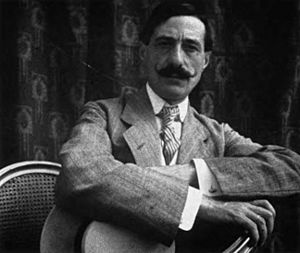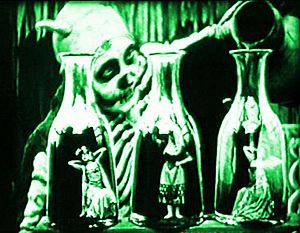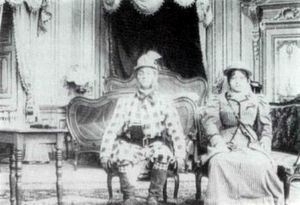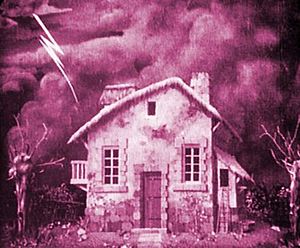Segundo de Chomón facts for kids
Quick facts for kids
Segundo de Chomón
|
|
|---|---|
 |
|
| Born |
Segundo Víctor Aurelio Chomón y Ruiz
17 October 1871 Teruel, Spain
|
| Died | 2 May 1929 (aged 57) Paris, France
|
| Years active | 1900–1927 |
| Spouse(s) | Julienne Mathieu |
Segundo de Chomón (born October 17, 1871 – died May 2, 1929) was a very important Spanish filmmaker. He was one of the first people to direct movies, film them, and write their stories. He made many short films in France for a company called Pathé Frères. People often compare him to another famous filmmaker, Georges Méliès, because Chomón loved using amazing camera tricks and visual illusions in his movies. He is known as the most important Spanish silent film director around the world.
Contents
Life and Early Work
Segundo de Chomón was born in Aragon, Spain. He likely got into filmmaking thanks to his French actress wife, Julienne Mathieu. She acted in early films for Pathé Frères and worked on special effects in Paris.
Around 1900, Chomón started working for Pathé Frères in Spain. He helped promote and distribute their films from Barcelona. In 1901, he began making his own short films in Spain. His first "trick film" was Gulliver en el país de los gigantes (1903). A trick film uses special effects to make impossible things happen on screen.
Chomón and his wife were also very good at adding color to films by hand, using stencils. They helped create the Pathéchrome process, which was a way to color films that Pathé patented in 1905. Charles Pathé, the head of Pathé Frères, noticed how good Chomón's trick films were. From 1903, Pathé started supporting Chomón's work to compete with Georges Méliès, who was also famous for trick films.
Moving to Paris and Major Films
In 1905, Chomón and his wife moved from Barcelona to Paris. Chomón became in charge of a film coloring workshop and continued directing. Until 1907, he worked closely with Pathé's main director, Ferdinand Zecca. Their teamwork was so good that in 1907, Zecca chose Chomón to help direct a big project: a remake of Zecca's 1903 film, Vie et Passion de Notre Seigneur Jésus Christ.
After this, Zecca took on a management role at Pathé and directed fewer films. Chomón's most active years as a filmmaker were from 1907 to 1912. During this time, Georges Méliès's film production slowed down a lot. Chomón often worked with other directors like Gaston Velle and Émile Cohl. Even though he stayed with Pathé, Chomón returned to Barcelona in 1910 and started his own film company, Iberico Films, but it didn't last long.
Work in Italy and Later Career
In 1912, Chomón was invited to make films in Italy. Besides directing his own movies, he also worked on special effects for other directors' films. A famous example is Giovanni Pastrone's epic film Cabiria (1914). Chomón mostly focused on visual effects and cinematography (the art of filming) during these years.
After 1917, Chomón mainly created visual effects for other people's movies. This included films like Guido Brignone's Maciste in Hell (1925) and Abel Gance's Napoléon (1927). Towards the end of his life, Chomón worked with an inventor named Ernest Zollinger to create a new way to make two-color films. Chomón was planning to start directing full-time again when he suddenly died from a heart attack at age 57.
His Legacy and Influence
After Chomón died, his work was largely forgotten for a while. However, over time, people who collected silent films started to recognize some of his short movies. He became known as "The Spanish Méliès" in English-speaking countries.
Two of his films, Le spectre rouge (1907) and Hôtel électrique (1908), were often seen by collectors and shown by the Museum of Modern Art. Le spectre rouge was shown as an example of stenciled color, and Hôtel électrique was shown as a Pathé Frères film by an unknown director.
The Italian film Cabiria, where Chomón was the director of photography and special effects, featured what might have been the very first "dolly shot" in movies. A dolly shot is when the camera moves smoothly on a track or wheels. Chomón built the device for this shot.
Finally, Chomón started to get recognition in his home country. The Filmoteca de Catalunya (a film archive in Catalonia) created a special department to collect and catalog his remaining films. In 2010, a DVD collection of 31 of his films, called Segundo Chomón: Le Cine de la Fantasia, was released. Many of his films made in Paris for Pathé Frères have been found, but his Spanish and Italian films are harder to find.
Chomón vs. Méliès
People often compare Chomón's work to that of Georges Méliès. Some say Chomón was a better filmmaker, while others say he just copied Méliès. While Méliès was amazing at discovering basic film editing and creating fantastic sets, Chomón was a bit more modern.
Chomón used a lot of animation, which he was a pioneer in. Méliès rarely used animation. Chomón also improved some techniques that Méliès had already tried, like in Les Kiriki, acrobates japonais (1907). Chomón's films also covered more types of stories than Méliès's. He started with "actuality films" (like documentaries) and continued working in that area. He also worked on regular dramatic films. Méliès started with actuality films too, but after he discovered trick films and fantasy, he mostly stuck to those.
Even so, Chomón is best remembered for his amazing trick films. Spain honored him with a postage stamp in 1994. His film Armures Mystérieuses (The Mysterious Armor) was preserved by the Academy Film Archive in 2010.
Film historian Tom Gunning has suggested that famous artists Luis Buñuel and Salvador Dalí might have seen Chomón's film Superstition andalouse (1912) years before they made their own experimental film Un Chien andalou in 1929.
Filmography
- 1901: Bajada de Montserrat
- 1902: Choque de trenes
- 1902: Danse des Ouléd-Naïd
- 1902: Loie Fuller
- 1902: Montserrat
- 1903: Pulgarcito
- 1903: Gulliver en el país de los Gigantes
- 1903: Los héroes del sitio de Zaragoza
- 1904: Barcelone, Le parc au crépuscule
- 1904: El heredero de Casa Pruna
- 1906: Le roi des dollars
- 1906: L'obsession du billard
- 1906: Le sorcier arabe
- 1906: Les cent trucs
- 1906: Le courant électrique
- 1906: La maison hantée (1906)
- 1906: La fée aux pigeons
- 1906: La dernière sorcière
- 1906: Plongeur fantastique
- 1906: L'homme aux trente-six têtes
- 1906: Le théâtre de Bob
- 1906: La maison hantée
- 1906: Ah! La barbe
- 1906: Hallucination musicale
- 1906: L’obsession de l’or
- 1906: Le mariage du roi Alphonse XIII
- 1906: Le troubadour
- 1906: L'antre de la sorcière
- 1906: Les roses magiques
- 1907: La Passion de Jésus
- 1907: Métempsycose
- 1907: Les tulipes
- 1907: Le scarabée d'or
- 1907: Le charmeur
- 1907: Le bailleur
- 1907: Les flammes diaboliques
- 1907: Le parapluie fantastique
- 1907: Fantaisies endiablées
- 1907: Le spectre rouge
- 1907: Les œufs de Pâques
- 1907: La fée des roches noires
- 1907: Les chrysanthèmes
- 1907: Le sculpteur express
- 1907: Silhouettes animées
- 1907: Armures mystérieuses
- 1907: Les verres enchantés
- 1907: La boîte à cigares
- 1907: Satan s'amuse
- 1907: L'étang enchanté
- 1907: Ali Baba et les quarante voleurs
- 1907: La forge infernale
- 1907: En avant la musique
- 1907: La maison morcelée
- 1907: Les Kiriki, acrobates japonais
- 1907: Les glaces merveilleuses
- 1907: Le baiser de la sorcière
- 1907: Métempsycose
- 1907: Le scarabée d'or
- 1907: La maison hantée''
- 1908: La table magique
- 1908: Voyage original
- 1908: Les œufs merveilleux
- 1908: L'araignée d'or
- 1908: Création de la serpentine
- 1908: Voyage oriental
- 1908: Le secret de la sorcière
- 1908: Le rêve des marmitons
- 1908: Les affiches animées
- 1908: Sculpteur moderne
- 1908: Voyage dans la lune
- 1908: Chiffonniers et caricaturistes
- 1908: Le rêve de Toula
- 1908: La grenouille
- 1908: Les lunatiques
- 1908: L'auberge tranquille
- 1908: L'insaisissable pickpocket
- 1908: Les papillons japonais
- 1908: La légende du fantôme
- 1908: Les flammes mystérieuses
- 1908: Déménagement magnétique
- 1908: Les tribulations du roi Tétaclaque
- 1908: Hôtel électrique
- 1908: L'aspirateur
- 1908: Les grotesques
- 1908: Cuisine magnétique
- 1908: Le chevalier mystère
- 1908: Hôtel électrique
- 1908: L'écran magique
- 1908: La grotte des esprits
- 1908: Mes fleurs
- 1908: Magie moderne
- 1908: L'abeille et la rose
- 1908: Le voleur mystérieux
- 1908: Les pantins de Misole
- 1908: Les ombres chinoises
- 1908: Les jouets vivants
- 1908: La maison ensorcelée
- 1909: Symphonie bizarre
- 1909: Le voleur invisible
- 1909: La liquéfaction des corps
- 1909: Les cocottes en papier
- 1909: Le petit Poucet
- 1909: L'âne de la sorcière
- 1909: La forge du diable
- 1909: Les cadeaux de la fée
- 1909: Le jeu de patience
- 1909: Farce macabre
- 1909: Cauchemar et doux rêves
- 1909: Les têtes fantastiques
- 1909: Voyage sur la planète Jupiter
- 1909: La leçon de musique
- 1909: Pickpock ne craint pas les entraves
- 1909: Une excursion incohérente
- 1909: Les guirlandes merveilleuses
- 1909: Mars
- 1909: Le Roi des aulnes
- 1909: Voyage au centre de la Terre
- 1910: Amor Gitano
- 1910: La expiación
- 1910: El puente de la muerte
- 1910: Venganza de un carbonero
- 1910: La fecha de Pepín
- 1910: La fatalidad
- 1910: El ejemplo
- 1910: Pragmática real
- 1910: Justicias del rey don Pedro
- 1910: La manta del caballo
- 1910: La hija del guardacostas
- 1910: La gratitud de las flores
- 1910: Flores y perlas
- 1910: Los guapos
- 1910: El puñao de rosas
- 1910: Las carceleras
- 1910: La tempranica
- 1910: El pobre Valbuena
- 1910: Lucha fratricida o Nobleza Aragonesa
- 1910: Los pobres de levita
- 1910: Los dulces de Arturo
- 1910: Una farsa de Colás
- 1910: Flema inglesa
- 1910: Gerona: la Venecia española
- 1910: La heroica Zaragoza.
- 1911: Pulgarcito
- 1912: El talismán del vagabundo
- 1912: Soñar despierto
- 1912 : Métamorphoses
- 1916 : La guerra e il sogno di Momi, directed with Giovanni Pastrone
See also
 In Spanish: Segundo de Chomón para niños
In Spanish: Segundo de Chomón para niños




